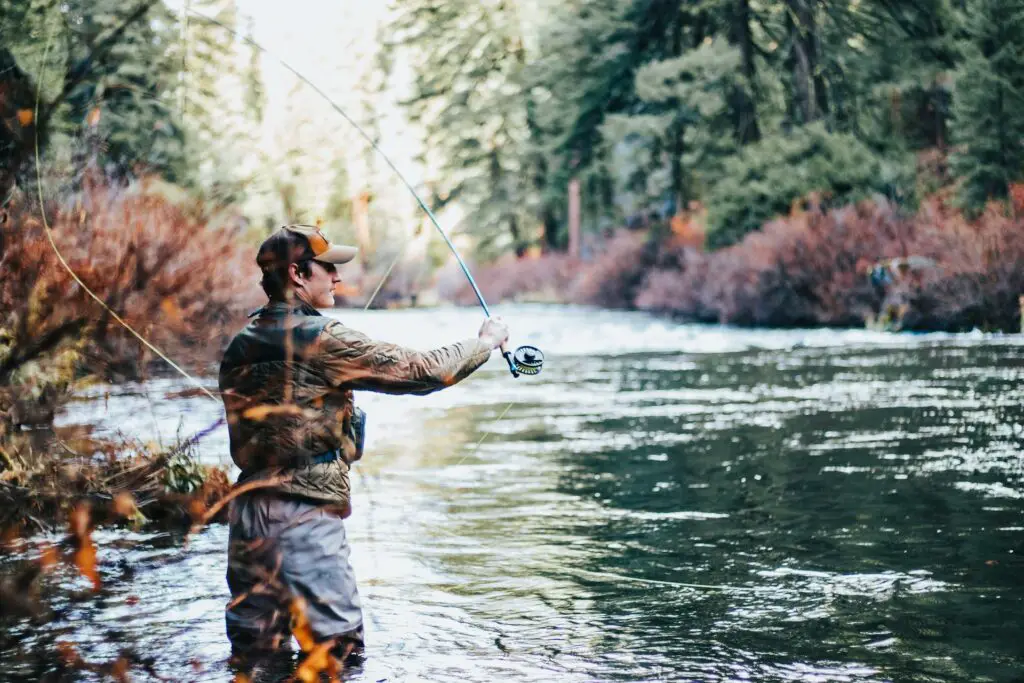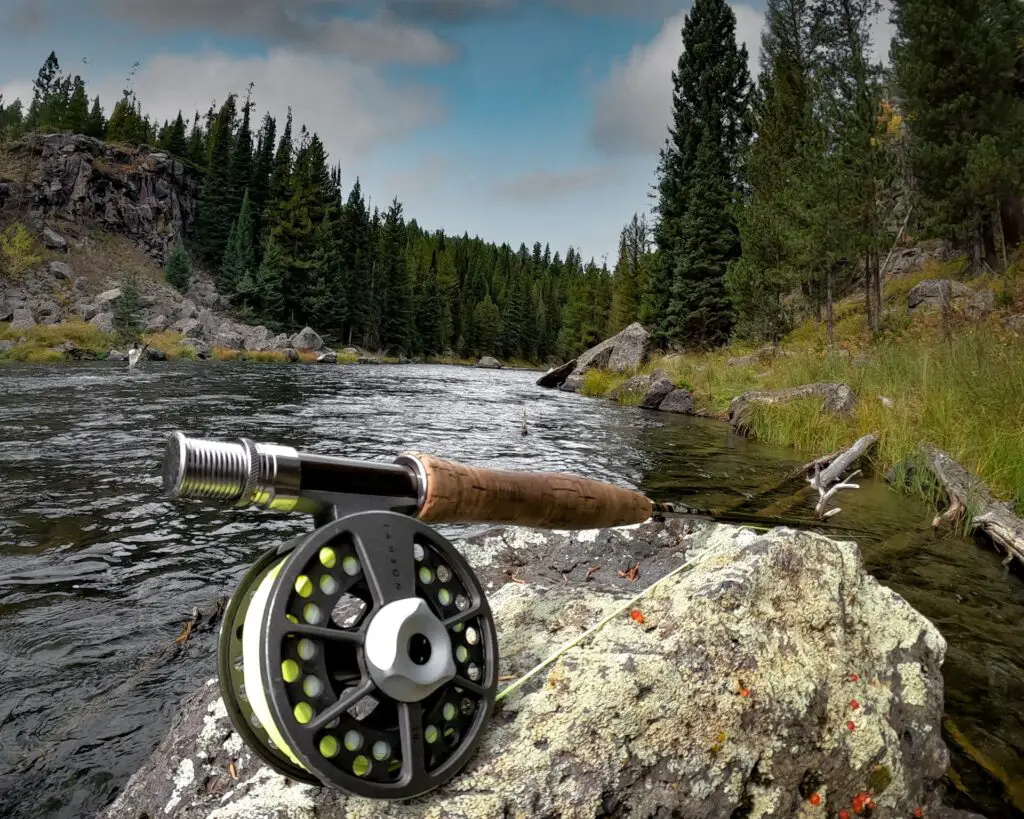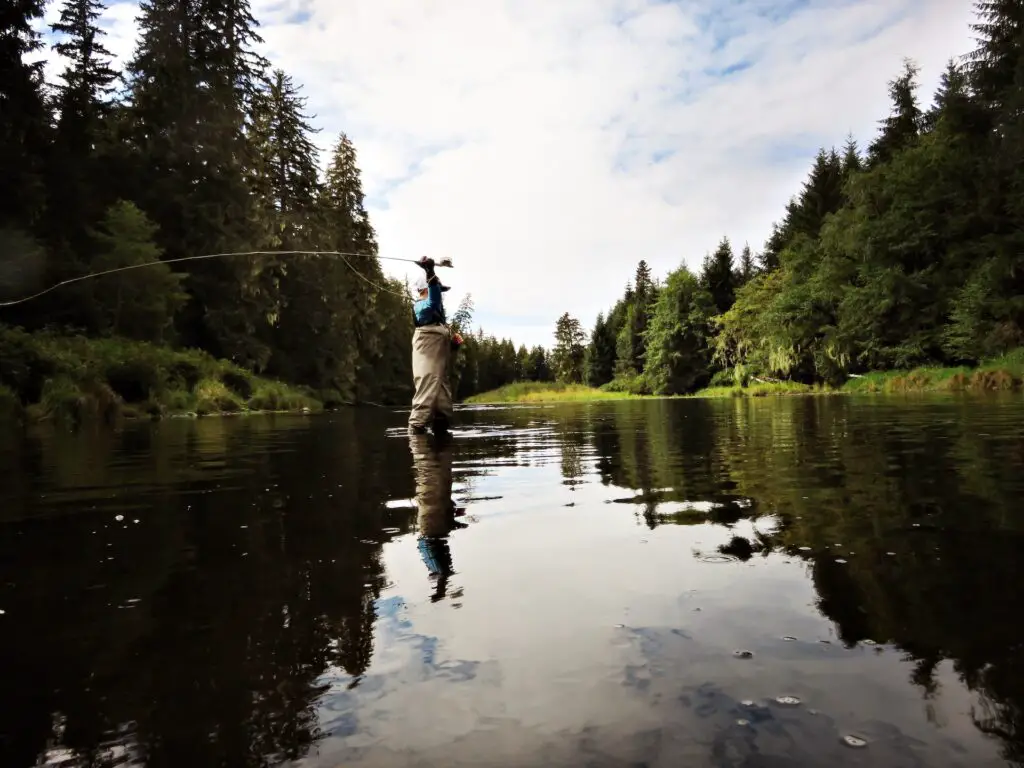There are no right or wrong choices when it comes to fly fishing. Experienced fly anglers have their fishing style and preferences – and their favorite fly fishing rod, of course. Unfortunately, things are not that straightforward for newbies looking to buy their first fly rod and they are often overwhelmed by the vast selection of different rods.
If you are new to fly fishing, you probably feel the same way too. Do not fret, though. It is perfectly normal to change a few fly rods before you find the one that meets all your needs. It is not a bad thing, either. You get to build a fly rod collection of different lengths, actions, and brands that will come in handy throughout your angling career.
My article will teach you how to choose a fly rod that will get you started. It will guide you through all the important features you should consider when shopping for your first all-around fly rod.
Let’s begin!
How To Select Your First Fly Rod?

Why is it important to choose the right fly rod?
When handled properly, fly rods enable anglers to cast their fly lines with great power and accuracy. Once you master basic fly casting skills, a fly rod is your best ally in presenting your lure without scaring the fish.
Once your fly is floating on the water, your fly rod serves to control the line and secure natural presentation. It takes a bit of practice to master this skill, but a good fly rod can help you achieve that faster.
When you feel a strike, you use your fly rod to set the hook and bring your catch out of the water. Fighting a fish can be quite challenging, and you need a reliable rod to handle the combat. It has to be strong and flexible enough not to snap under the pressure.
To break free of confusion and choose the right rod for your needs, check out my step-by-step fly rod selection guide. It will give you a better idea of what kind of fly rod to buy and why.
Determine The Type Of Fish You’ll Be Fishing For
Ask yourself the following questions:
- Are you going to target saltwater fish species or freshwater fish?
- Do you plan to hook a big fish or a small fish?
The fly fishing gear you use in a freshwater environment won’t perform very well in harsh saltwater fly fishing conditions. Likewise, a fly rod you use to target small panfish or trout is not the same as the rod used to target a trophy bass. Think things through and decide what type of fish you’ll be targeting!
Determine The Fly Rod Action
Fly rod action is one of the most confusing aspects of fly fishing. However, it is not as complicated as it seems. The fly rod action shows how flexible a rod is. You measure it on the back cast. The more your rod bends on the back cast, the more flexible it is.
As a newbie, you should concentrate on the following three types of fly rods:
- Fast-Action Fly Rods
Fast-action rods are also known as tip-flex rods since only their tip bends. Their stiffness provides more casting power and better stability when fishing in windy conditions.
These rods are also less physically demanding. When using a fast-action rod, you do not need to work as hard to cast your lure at the desired distance as with slower-action rods. Fast-action rods are not the best choice for beginner fly fishermen. The lack of flexibility makes it harder to feel the line and fly and achieve a precise cast.
These fly rods are also a bad option when you want to perform short casts. They are not very subtle and accurate when fishing in small streams. The line often hits the water with force and spooks the fish.
- Medium-Action Fly Rods
Medium action, or mid-flex fly rods, are the most versatile fly rods you can buy. You can use them in most conditions, and they do not require such a steep learning curve as their fast-action counterparts.
A medium-action fly rod flexes around half its length. It is an ideal choice for freshwater trout fishing.
- Slow-Action Fly Rods
Slow action fly rods, also known as full flex rods, are the most flexible fly rods. They can bend to a 90-degree angle.
Full flex fly rods are perfect for beginners and can help you learn fly fishing basics. They are much more forgiving than the other types of fly rods. Ideally, you should use a slow-action fly rod to target small fish species such as panfish or brook trout. So, if you fish small streams, be sure to get one!
Determine The Appropriate Line Weight
Line weight shows how heavy or light your fishing line is. Why is that important?
When casting an ultra-light fly, the weight of the line plays a crucial role. If you choose the wrong weight, you are likely to face a number of issues, including lack of line control and casting precision.
You need to match the size of your fly to the weight of your line. You cannot combine an ultralight fly and a heavy-weight line. The heaviness of the line would pull the fly down too fast, create a splash, and scare the fish.
The same goes the other way around. Combining a heavy fly and a light line would result in a complete lack of control.
Therefore, to avoid problems, check the labels when buying the fishing line and lures in your local fly shop. A fly line weight is measured in grains. You can choose a fly line labeled from number 1 (ultralight line) to 14 or even more (heavy line).
How can you know when to use different line weights?
If you haven’t skipped the first step of this tutorial, you’ll resolve this quite quickly – simply use the weight of the fly line that best suits the fish you are targeting:
- Use line weight 1-3 for targeting panfish and small trout
- Use line weight 4 for medium-sized fish (trout, steelhead, etc.)
- Use line weight 5 for larger trout and average bass
- Use line weight 6 for bass and smaller salmon
- Use line weight 7 for bass fishing, monster trout fishing, and targeting medium-sized salmon
- Use line weight 8 and up for large & strong saltwater species

It is crucial to match your fly rod with the appropriate fly line. So, always match the line weight, rod weight, and reel weight. Many new anglers use this formula to improve their fishing experience.
How does it work in practice?
It is so simple! If you buy a 5-weight fly rod, purchase a 5-weight line and 5-weight reel as well. You can go one level up or down too, but that could compromise your performance.
Extra Advice:
Heavier line weights are more difficult to cast. If you are a newbie, start with lighter lines and work your way up.
Check out the following video for additional beginner fly casting advice:
Determine The Fly Rod Length
The choice of fly rod length depends on the type of fish you are targeting and the fishing environment you plan to fly fish in. The most common rod lengths fly anglers use are 8 and 9 feet, while most trout rods are 7 to 9 feet long,
In general, 9 feet fly rods are best suited for those who use a heavy fly line, require long casts, and do not mind the extra weight. They are the top choice for nymph fishing too.
An 8.5 feet long rod is an all-around rod appropriate in most fishing conditions. If you are unsure which length to choose, feel free to buy this one. It is fairly wind-resistant and can handle both long casts and short casts.
Choosing a fly rod that is 8 feet long (or shorter) enables you to make short and precise casts even in windy conditions. It is an ideal solution for small stream fishing and targeting tiny fish with a light fly line.
What Else To Consider When Choosing A Fly Rod?

- Material
Even though fly rod manufacturers slowly give up on fiberglass rods, you can still find them in some fly shops. However, you should still get a graphite fly rod.
Graphite rods are lighter and stronger than the ones made of fiberglass. That is why most fly rod manufacturers produce them in the first place.
- Mobility
If you are a fisherman on the go, you need a fly rod that packs up easily. Luckily for you, there are “travel rods” that break into more than two pieces (such as four-piece rods). These multi-piece rods are ideal for fly fishers who often travel by plane.
- A ready-made fly rod combo
A fly rod combo saves you the trouble of choosing the appropriate fly rod reel and fly line to go with your new fly rod. Everything is already included and installed for you by experienced rod designers – plus, it is usually cheaper too! It is an ideal solution for beginner fly fishers, especially if they haven’t already invested in some pieces of the fly rod outfit.
- Price
We all have a budget to consider. Still, I would not advise you to be thrifty when buying your fly fishing gear. Generally speaking, a reliable fly rod costs at least twice as much as a decent fly reel.
Do not hesitate to open your wallet when you visit your local fly shop for the first time. Buy the best fly rod you can afford! You are investing in your future fly fishing success!
How To Choose A Fly Rod: The Best Tips & Tricks
- Avoid extremes when choosing your first fly rod. A medium action rod and medium-fast action rod are easiest to cast as they are neither too soft nor too stiff.
- You should choose a slow-action rod only if you plan to fish in small streams and spring creeks exclusively.
- If in doubt, choose a four-piece rod rather than a standard two-piece one. It is just as good, plus easier to pack up and carry around when you travel.
The following video has some great tips on choosing the right fly rod too:
FAQs
How do I choose the right size fly rod?
To choose the right size fly rod, you must consider the size/weight of your fly rod reel and the fishing line. Fly rods range in size from 1 weight to 14 weight. If you have a 5-weight reel and a 5-weight line, choose a 5-weight fly rod as well.
What is the difference between a 5 and 6-weight fly rod?
There is not much difference between a 5 and 6-weight fly rod. Both are excellent all-around options. The main difference is that the 6-weight rod allows you to throw larger flies while still being able to throw small dry flies.
What is a 5-weight fly rod good for?
A 5-weight fly rod is an excellent all-around rod you can use in almost any freshwater fishing situation. You can use a 5-weight fly rod to target smaller fish species such as trout or bluegills, as well as bass, perch, whitefish, carp, and catfish.
What is an 8 foot fly rod good for?
An 8 foot fly rod is good for numerous fishing applications. Short rods such as this are generally the best option for targeting trout and other small fish in streams and brooks. They deliver better accuracy than longer rods.
What is a 10 foot fly rod used for?
A 10 foot fly rod is used for situations when anglers require added power and casting distance. In general, longer rods are perfectly suited for fishing in big rivers and targeting large fish. A long rod shortens the fight with your catch too.
Final Words Of Wisdom

Your first rod should be versatile but also suitable for the water you fish in most often and the fish species you target most frequently. All you have read so far should have enabled you to choose the perfect fly rod action, size, and length, as well as the matching fly line and fly reel.
In short: You should be ready to fly fish! So what are you waiting for? Go to the nearest fly shop, and get a fly rod you will love. It will inspire you to fly fish and improve your casting style! If I can help you in any way, leave a comment.
